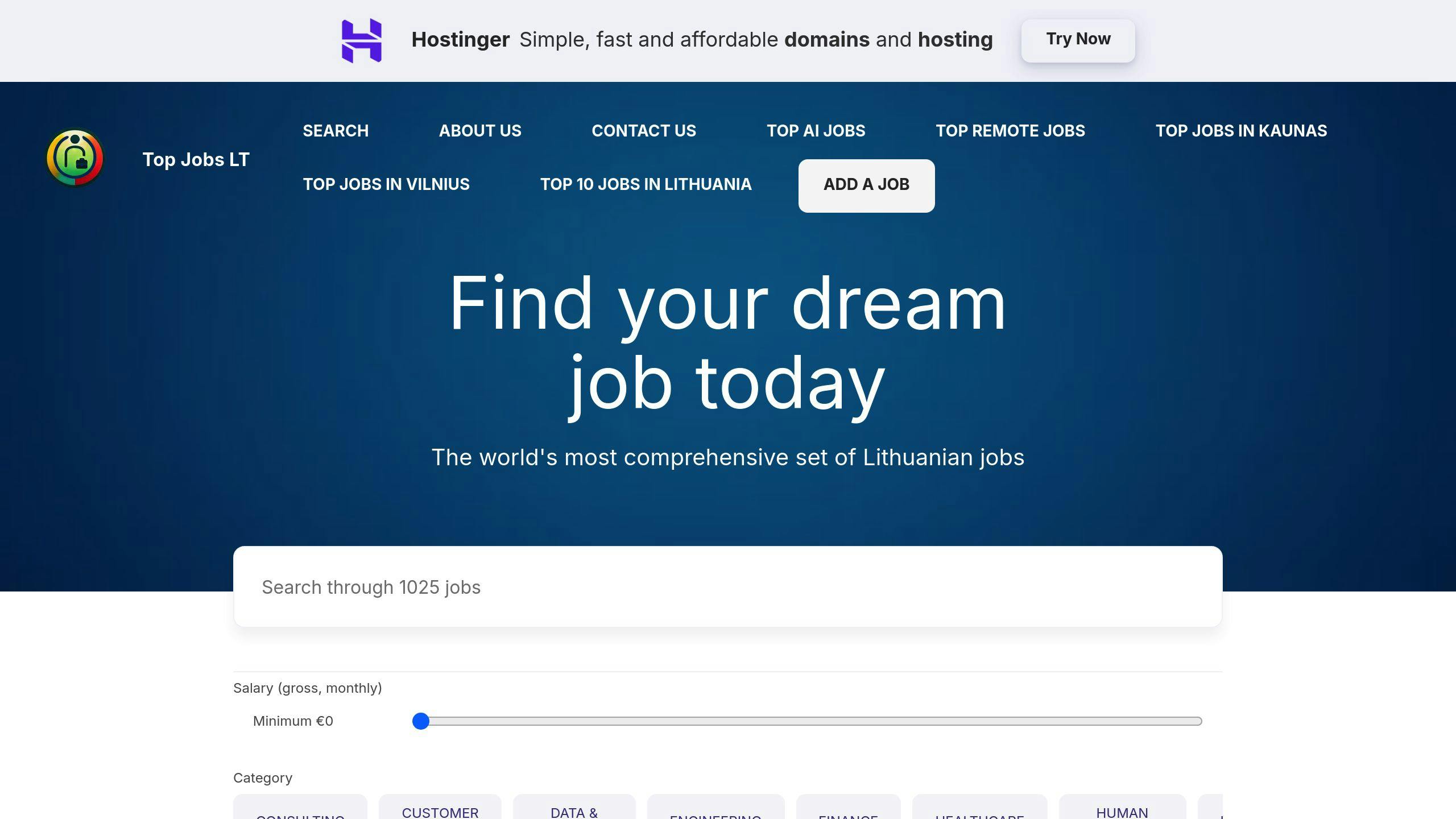Want to land a job in Lithuania? Start with a standout CV. Lithuanian employers prefer concise, formal CVs tailored to their market. Here's what you need to know:
- Format: Use the Europass format for structure and professionalism.
- Length: Keep it to 1-2 pages.
- Language: Use Lithuanian for local roles, English for international ones.
- Key Sections: Contact info, professional summary, work experience (with measurable achievements), education, skills, and optional extras like awards.
- Style: Stick to a clean design, reverse chronological layout, and standard fonts like Arial.
Quick Comparison: Lithuanian CV vs. International CV
| Aspect | Lithuanian CV | International CV |
|---|---|---|
| Length | 1-2 pages | Often 3+ pages |
| Language | Lithuanian/English | Usually English |
| Format | Structured, formal | Flexible formatting |
| Personal Info | Includes more details | Limited information |
Tailor your CV to the job, focus on quantifiable achievements, and use platforms like Top Jobs LT to apply. Lithuania's growing demand in IT, healthcare, and manufacturing makes this the perfect time to stand out with a polished CV.
1: Structuring Your CV for Lithuania
Choosing a CV Format
In Lithuania, the Europass format is widely accepted as it ensures uniformity and effectively highlights your qualifications [1]. Here's what you should keep in mind when selecting a CV format:
| Format Element | Lithuanian Preference | Why It Matters |
|---|---|---|
| Layout | Reverse chronological | Clearly outlines your career journey |
| Length | 1-2 pages maximum | Keeps the content focused |
| Design | Clean and professional | Reflects attention to detail |
| Font | Standard (Arial, Times New Roman) | Ensures easy readability |
Once you've settled on the format, focus on including the right sections to make your CV stand out.
CV Sections to Include
To present yourself effectively in the Lithuanian job market, your CV should include the following sections in this order:
- Contact Information: Start with your full name, phone number, and a professional email address.
- Professional Summary: A brief snapshot of your qualifications and career goals.
- Work Experience: Highlight relevant roles, emphasizing key achievements and responsibilities.
- Education: List your academic background and any certifications.
- Skills: Include technical abilities, language proficiencies, and soft skills that match the job.
- Additional Information: Use this optional section for awards, volunteer work, or other notable accomplishments.
Keeping It Clear and Concise
Lithuanian employers value straightforward and efficient communication [1][3]. To ensure your CV meets these expectations:
- Stick to short, impactful sentences and avoid overcomplicated language.
- Use specific metrics to showcase your achievements (e.g., "Increased sales by 20%").
- Keep the layout clean with plenty of white space and use bullet points for easy scanning.
With a well-organized and concise CV, you'll be ready to impress Lithuanian employers.
2: Writing Each Section of Your CV
Personal Information and Photo Guidelines
Start your CV with a clear and professional personal information section. Write your full name in bold, using a font size of 14-16pt (e.g., Jonas Kazlauskas). Follow this with your contact details, including:
- Phone number with the country code (e.g., +370 6XX XXXXX)
- Professional email address (e.g., firstname.lastname@email.com)
- Location (city and country)
If you decide to include a photo, make sure it’s recent (taken within the last six months), professional, passport-style, and high-quality (at least 300dpi).
Once you’ve completed this section, you’re ready to focus on presenting your work history and accomplishments.
Work Experience: Focus on Achievements
In Lithuania, employers value specific, measurable achievements over generic descriptions of duties [1]. For each position, include:
- Company name and location
- Job title
- Employment dates (MM/YYYY)
- 3-4 key achievements with quantifiable results
For instance, instead of saying "Responsible for sales", write something like: "Generated €250,000 in new business revenue in Q4 2024."
Highlighting leadership or teamwork is also impactful. For example: "Led a cross-functional team of 8 members to deliver 3 major projects ahead of schedule."
After detailing your career accomplishments, shift the focus to your educational background and relevant skills.
Education and Skills: What to Include
In the education section, include:
- Full name of the institution
- Degree title (translated into Lithuanian for local roles)
- Graduation date (or expected completion)
- Relevant coursework related to the job
Organize your skills into categories for clarity. Examples include:
- Technical skills: Programming languages, software expertise
- Language skills: List CEFR levels (e.g., Lithuanian C2, English C1)
- Professional competencies: Project management, team leadership
- Industry-specific skills: Financial analysis, digital marketing
Tailor this section to match the skills required for the role [3].
How to Write Best CV for Europe
sbb-itb-447d166
3: Customizing Your CV for Lithuanian Employers
Once you've structured and written your CV, the next step is to fine-tune it for specific employers and industries.
Language Preferences: Lithuanian vs. English
For international positions, stick to English. For local companies, opt for Lithuanian unless they specify otherwise. It's a good idea to have two versions of your CV ready - one in each language.
Adapting to Industry Standards
Different industries in Lithuania look for different things in a CV. Here’s how to align your CV with key sectors:
| Industry | Key Focus Areas |
|---|---|
| IT & Tech | Highlight certifications, technical skills, and tools |
| Finance | Showcase financial credentials and measurable results |
| Manufacturing | Include safety certifications and process improvement metrics |
With labor shortages in IT, healthcare, and manufacturing [5], showcasing relevant skills and certifications can make your application stand out.
Cultural Tips for CV Writing
Lithuanian employers value modesty and accuracy in CVs [1]. Avoid exaggeration, use formal language, and focus on concrete achievements rather than subjective claims.
Your CV should demonstrate an understanding of industry trends while adhering to cultural expectations. Once it's tailored to Lithuanian standards, you're ready to polish it for submission.
4: Finalizing and Applying for Jobs
Proofreading and Formatting Your CV
Carefully review your CV for errors and consistency before submitting it. Stick to a clean, professional design - use fonts like Arial or Calibri (size 11-12), maintain 2.5 cm margins, and save the final version as a PDF. If you're preparing a Lithuanian CV, double-check grammar and terminology. For English CVs, use British English spelling to align with European preferences.
Once your CV is polished and ready, you can start your job search on Lithuania's most popular platforms.
Using Top Jobs LT for Job Applications

Top Jobs LT is a go-to resource for navigating Lithuania’s job market. Start by creating a detailed profile, uploading both your Lithuanian and English CVs, and setting up job alerts for roles that match your skills. The platform’s search filters make it easier to find opportunities that align with your experience and salary goals. This is particularly helpful in high-demand fields like IT, healthcare, and manufacturing [4].
When you find roles that interest you, focus on crafting personalized applications that grab attention.
Submitting Your Job Application
Whether applying through job portals or email, keep your communication professional and straightforward. Here's a simple structure to follow:
- Subject Line: [Position Title] - [Your Name]
- Body: Briefly introduce yourself, mention the position you're applying for, and note the attached documents.
Make sure to name your attachments clearly (e.g., "FirstName_LastName_CV.pdf"). If you don’t hear back, consider following up after 5-7 business days.
With a growing demand for skilled professionals in Lithuania [5], a well-prepared application can make a strong impression. Emphasize relevant skills and certifications, especially if you're targeting industries like IT, healthcare, or manufacturing [4].
Conclusion: Key Points for a Lithuanian CV
Recap of Key CV Tips
We've covered all the steps to craft a CV tailored for Lithuania. Here's what stands out: the Europass format is widely used in Lithuania, so it's a safe choice. Use Lithuanian for local positions and English for international roles unless specified otherwise [1].
Lithuania's economy is expanding, and there's a strong need for skilled professionals, especially in IT, healthcare, and manufacturing [4]. With labor shortages and an aging workforce, these fields are actively seeking qualified candidates.
| Key CV Elements | Importance |
|---|---|
| Language Choice | Creates a strong first impression and shows awareness of local practices |
| Skills Section | Highlights the abilities most relevant to the job |
| Language Proficiency | Should be listed using CEFR levels (A1-C2) |
Preparing for the Job Market
Now that you have the essentials, it’s time to focus on the next steps. Emphasize measurable achievements and tailor your skills to sectors like IT, healthcare, or manufacturing [4]. When using job platforms such as Top Jobs LT, make sure your profile matches the professionalism of your CV.
Delivering a polished application that reflects Lithuanian business culture will help you stand out [2]. By following these guidelines and targeting high-demand areas, you'll boost your chances of securing a job in Lithuania's competitive market.


